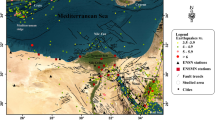Abstract
We define here a new measure of epicentral shaking intensity (modified spectrum intensity), which we derive from strong motion instrumental data. This new metric is similar to Housner’s spectrum intensity, with the caveat that we modify its numerical value by evaluating the predominant period of spectral acceleration and the site characteristics of each strong-motion station. We find that the modified spectrum intensity thus calculated is of higher reliability than peak ground acceleration, peak ground velocity, or Housner’s spectrum intensity in instrumental seismic intensity determination, and it offers a superior method to evaluate macro-seismic intensity distribution soon after a destructive earthquake in Western China.






Similar content being viewed by others
References
Atkinson GM, Kaka SI (2007) Relationships between felt intensity and instrumental ground motion in the Central United States and California. Bull Seismol Soc Am 97:497–510
Boatwright J, Thywissen K, Seekins LC (2001) Correlation of ground motion and intensity for the 17 January 1994 Northridge, California, earthquake. Bull Seismol Soc Am 91:739–752
Chernov YK, Sokolov VY (1999) Correlation of seismic intensity with Fourier acceleration spectra. Phys Chem Earth Part A: Solid Earth Geodesy 24(6):523–528
Davenport PN (2003) Instrumental measures of earthquake intensity in New Zealand. In: Proceedings of the 7th Pacific conference on earthquake engineering, Christchurch, New Zealand, paper no. 071
Erdik M, Fahjan Y, Ozel O, Alcik H, Mert A, Gul M (2003) Istanbul earthquake rapid response and the early warning system. Bull Earthq Eng 1:303–312
Fahjan YM, Alcik H, Sari A (2011) Applications of cumulative absolute velocity to urban earthquake early warning systems. J Seismol 15:355–373
Housner GW (1952) Spectrum intensity of strong-motion earthquakes. Proceedings of the symposium on earthquake and blast effects on structures, Oakland, California, In, pp 20–36
Kaka SI, Atkinson GM (2004) Relationships between instrumental ground-motion parameters and modified Mercalli intensity in Eastern North America. Bull Seismol Soc Am 94:1728–1736
Karim KR, Yamazaki F (2001) Estimation of the JMA seismic intensity from liquefied record and its correlation with strong motion parameters. In: Proceedings of the 26th Japan earthquake engineering symposium, Sapporo, Japan, pp 253–256
Karim KR, Yamazaki F (2002) Correlation of JMA instrumental seismic intensity with strong motion parameters. Earthq Eng Struct Dyn 31:1191–1212
Li X-J, Zhou Z-H, Yu H-Y, Wen R-Z, Lu D-W, Huang M, Zhou Y-N, Cu JW (2008) Strong motion observation and recording from the great Wenchuan earthquake. Earthq Eng Eng Vib 7:235–246
Linkimer L (2008) Relationship between peak ground acceleration and modified mercalli intensity in Costa Rica. Rev Geol Am Cent 38:81–94
Margottini C, Molin D, Serva L (1992) Intensity versus ground motion: a new approach using Italian data. Eng Geol 33:45–58
Rosenberger A, Rogers GC, Cassidy JF (2007) The new real time reporting strong motion seismograph network in Southwest BC: more strong motion instruments for less money. In: Proceedings of the 9th Canadian conference on earthquake engineering, Ottawa, Canada, pp 26–29
Shabestari KT, Yamazaki F (2001) A proposal of instrumental seismic intensity scale compatible with MMI evaluated from three-component acceleration records. Earthq Spectra 17:711–723
Sokolov VY, Chernov YK (1998) On the correlation of seismic intensity with Fourier amplitude spectra. Earthq Spectra 14:679–694
Sokolov VY (2002) Seismic intensity and Fourier acceleration spectra: revised relationship. Earthq Spectra 18:161–187
Sun JJ, Yuan YF, Wen ZP, Li XJ, Du W, Lin JQ, Li SY, Zhang LX, Liu AW, Zhao FX, Meng QL, Lju HS (2008) The Chinese seismic intensity scale. China National Standard, GB/T 17742–2008
Trifunac MD, Brady AG (1975) A study on the duration of strong earthquake ground motion. Bull Seismol Soc Am 65:581–626
Trifunac MD, Westermo B (1977) A note on the correlation of frequency-dependent duration of strong earthquake ground motion with the modified mercalli intensity and the geologic conditions at the recording stations. Bull Seismol Soc Am 67:917–927
Wald DJ, Quitoriano V, Heaton TH, Kanamori H, Scrivner CW, Worden CB (1999a) TriNet ShakeMaps: rapid generation of peak ground motion and intensity maps for earthquakes in southern California. Earthq Spectra 15:537–556
Wald DJ, Quitoriano V, Heaton TH, Kanamori H (1999b) Relationships between peak ground acceleration, peak ground velocity and modified mercalli intensity in California. Earthq Spectra 15:557–564
Wang YS, Zhou ZH, Wang W (2008) A hypothesis testing based method for seismic intensity rapid assessment by strong ground motion parameters. J Earthq Eng Eng Vib 28(5):49–54 (in Chinese)
Wang YS, Zhou ZH, Lan RQ (2010) A proposed method for instrumental intensity determination in West China using modified spectrum intensity. J Basic Sci Eng 18(s1):119–129 (in Chinese)
Wells DL, Coppersmith KJ (1994) New empirical relationships among magnitude rupture length, rupture width, rupture area, and surface displacement. Bull Seismol Soc Am 84:974–1002
Wu YM, Shin TC, Chang CH (2001) Near real-time map** of peak ground acceleration and peak ground velocity following a strong earthquake. Bull Seismol Soc Am 91:1218–1228
Wu YM, Teng TL, Shin TC, Hsiao NC (2003) Relationship between peak ground acceleration peak ground velocity, and intensity in Taiwan. Bull Seismol Soc Am 93:386–396
Zhao JX, Zhang J, Asano A, Ohno Y, Oouchi T, Takahashi T, Ogawa H, Irikura K, Thio HK, Somerville PG, Fukushima Y, Fukushima Y (2006) Attenuation relations of strong ground motion in Japan using site classification based on predominant period. Bull Seismol Soc Am 96:898–913
Acknowledgments
This research work was supported by National Natural Science Foundation of China (51208475), the National Program on Key Basic Research Project of China (973 Program, 2011CB013601), and Special Research Fund for Seismic Industry of China (201108003). And we owed lots of thanks to Professor Atilla Ansal and the other two anonymous reviewers for their constructive comments.
Author information
Authors and Affiliations
Corresponding author
Rights and permissions
About this article
Cite this article
Wang, Y., Li, X. & Zhou, Z. A new instrumental measure of epicentral shaking intensity in Western China. Bull Earthquake Eng 11, 913–924 (2013). https://doi.org/10.1007/s10518-013-9428-5
Received:
Accepted:
Published:
Issue Date:
DOI: https://doi.org/10.1007/s10518-013-9428-5




